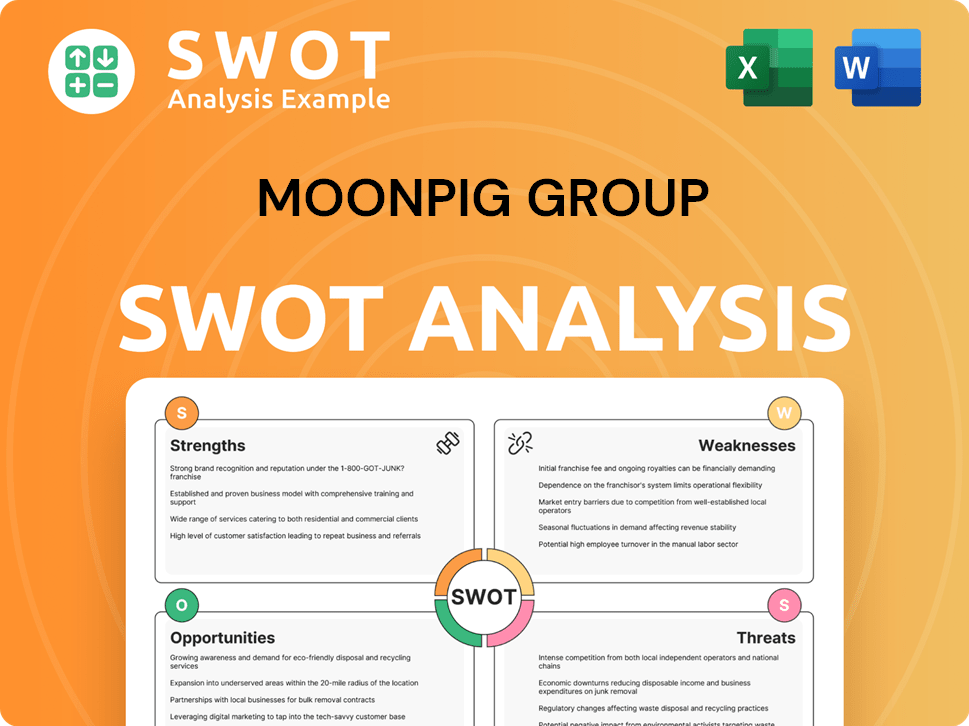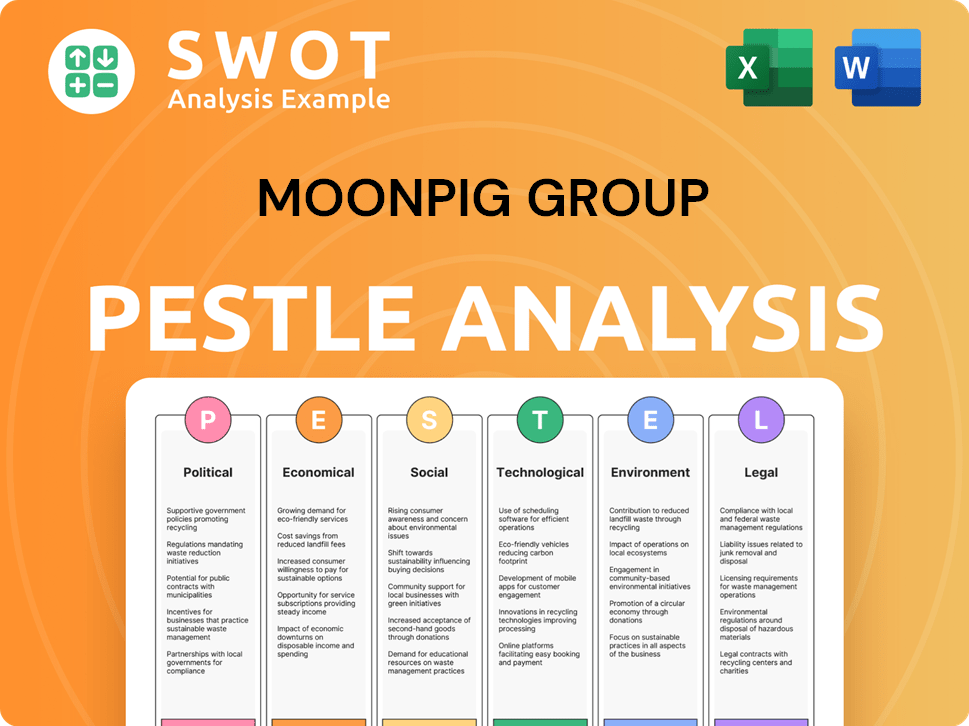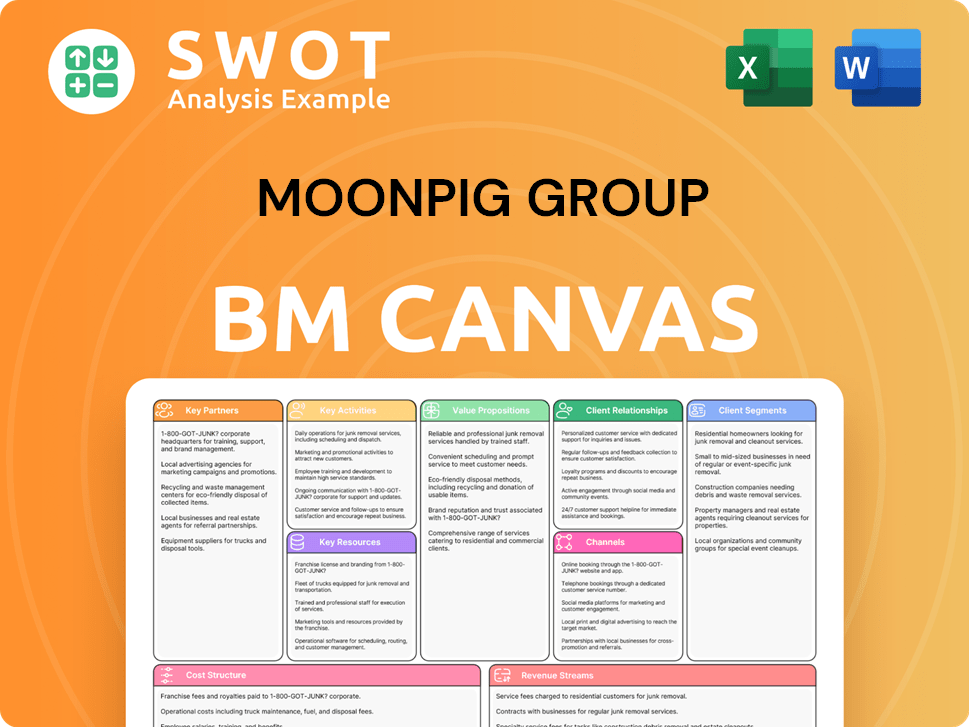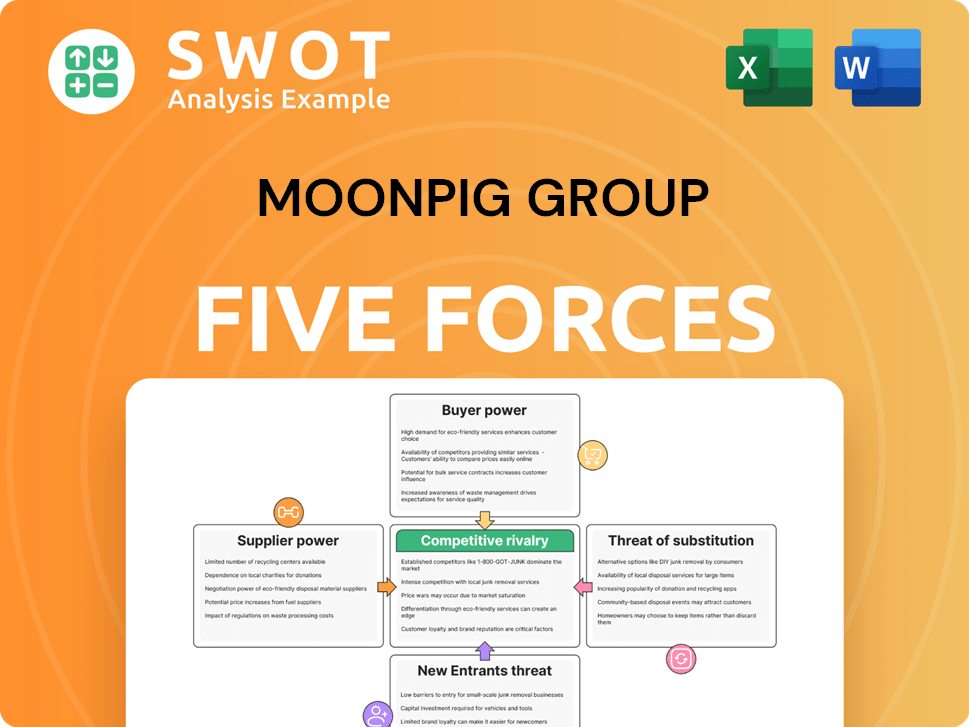Moonpig Group Bundle
Who Really Owns Moonpig Group?
Ever wondered who steers the ship at Moonpig Group? Understanding the ownership structure is key to grasping the company's future. From its humble beginnings to its current status as a public entity, the evolution of Moonpig's ownership tells a fascinating story. This deep dive explores the critical players and their influence on this e-commerce giant.

Moonpig Group, a prominent player in the online greetings and gifting market, has seen significant shifts in its ownership since its founding in 2000. Examining the Moonpig Group SWOT Analysis reveals how these changes have shaped its strategic direction. This analysis will unravel the details of Moonpig shareholders, its parent company, and the key investors who have influenced its growth, providing insights into the company's governance and market position. Discover who owns Moonpig's shares and how this impacts the company's trajectory.
Who Founded Moonpig Group?
The online greeting card and gifting platform was established in 2000 by Nick Jenkins. Initially, Jenkins held a significant ownership stake, driving the company's mission to revolutionize the traditional greeting card market with personalized online offerings. The early ownership structure was crucial for setting the stage for future growth.
Early-stage technology companies like this often rely on a combination of founder capital, angel investments, and seed rounds from friends and family. These early investments typically come with agreements designed to protect the founders' long-term commitment and ensure the company's stability, such as vesting schedules for founder shares.
The initial distribution of control, with Jenkins at the helm, was intrinsically linked to the founding team's vision for a convenient and customizable online gifting platform. Early agreements likely included clauses for future funding rounds and potential exit strategies for early investors, laying the groundwork for the company's eventual expansion. Understanding the Growth Strategy of Moonpig Group is essential to grasp how the company evolved.
The early ownership structure reflected the confidence of initial investors in Jenkins's innovative concept and the potential of e-commerce for personalized products. The company's trajectory from its inception was shaped by these early decisions.
- Nick Jenkins: Founder and initial significant shareholder.
- Early Investors: Angel investors and potentially friends and family provided early capital.
- Agreements: Included clauses for future funding rounds and exit strategies.
- Vision: Focused on a convenient and customizable online gifting platform.
Moonpig Group SWOT Analysis
- Complete SWOT Breakdown
- Fully Customizable
- Editable in Excel & Word
- Professional Formatting
- Investor-Ready Format

How Has Moonpig Group’s Ownership Changed Over Time?
The evolution of Moonpig Group's ownership has been marked by pivotal events, beginning with its acquisition by Photobox Group in 2011. This move, valued at £120 million, integrated the company into a larger e-commerce structure, shifting ownership from the founder and early investors to Photobox's shareholders. This was a crucial step in the company's journey, setting the stage for future developments.
The most significant change occurred in February 2021 when Moonpig Group plc went public on the London Stock Exchange. The IPO valued the company at approximately £1.2 billion, with shares offered at 350 pence each. This transition introduced a diverse shareholder base, including institutional and retail investors, increasing transparency and accountability. The move to public ownership has reshaped the company's strategic direction, subjecting it to the scrutiny of a broader investor community.
| Event | Date | Impact on Ownership |
|---|---|---|
| Acquisition by Photobox Group | July 2011 | Transferred ownership to Photobox shareholders. |
| Initial Public Offering (IPO) | February 2021 | Introduced public shareholders, diversifying ownership. |
| Ongoing | April 2025 | Institutional investors like BlackRock and AXA S.A. hold significant stakes. |
As of April 2025, Moonpig Group's major shareholders include prominent institutional investors. BlackRock, Inc. holds a substantial stake, reporting 7.02% ownership as of April 30, 2025. AXA S.A. holds 5.09% as of April 30, 2025, reflecting the significant influence of institutional investors. This structure underscores the company's evolution from private ownership to a publicly traded entity, shaped by strategic acquisitions and a successful IPO. For further insights, explore the Marketing Strategy of Moonpig Group.
The ownership structure of Moonpig Group has evolved significantly over time.
- Photobox acquisition in 2011 was a key strategic move.
- The 2021 IPO brought in a diverse group of shareholders.
- Institutional investors like BlackRock and AXA S.A. hold major stakes.
- Public ownership has increased transparency and accountability.
Moonpig Group PESTLE Analysis
- Covers All 6 PESTLE Categories
- No Research Needed – Save Hours of Work
- Built by Experts, Trusted by Consultants
- Instant Download, Ready to Use
- 100% Editable, Fully Customizable

Who Sits on Moonpig Group’s Board?
The Board of Directors of the Moonpig Group, a publicly listed company, is structured to include a mix of executive leadership, major shareholders, and independent experts. This composition reflects the company's public ownership status. While specific board members directly representing major institutional shareholders like BlackRock or AXA are not always explicitly identified as direct appointees, these significant investors typically influence decisions through their voting power on resolutions and director appointments. The voting structure for Moonpig Group generally follows the one-share-one-vote principle, which is standard for companies listed on the London Stock Exchange, ensuring voting power aligns with shareholding.
As of early 2025, the board includes key executive directors such as the CEO and CFO, alongside non-executive directors who provide independent oversight and strategic guidance. Kate Swann serves as the Non-Executive Chair, bringing considerable experience. Other board members have backgrounds in technology, retail, and finance, contributing to a diverse skill set for governance. The board's decisions are continuously shaped by engagement with major institutional shareholders and adherence to corporate governance best practices for a publicly traded entity. Understanding the Growth Strategy of Moonpig Group also provides insights into the company's operational direction.
| Board Member | Role | Background |
|---|---|---|
| Kate Swann | Non-Executive Chair | Extensive retail experience |
| CEO | Executive Director | Leadership within the company |
| CFO | Executive Director | Financial expertise |
The Moonpig company's governance structure ensures that the board is accountable to its shareholders. Understanding the composition of the board and the voting dynamics provides insight into the decision-making processes that influence the company's strategic direction and financial performance. This structure is crucial for maintaining investor confidence and ensuring the long-term success of Moonpig within the competitive online greeting card and gifting market.
The Board of Directors includes executive and non-executive members, ensuring diverse expertise. The voting structure is based on the one-share-one-vote principle, common for publicly listed companies. Major institutional investors influence decisions through their voting power.
- The board comprises executive and non-executive directors.
- Voting power is proportional to shareholding.
- Major shareholders influence decisions.
- The company adheres to corporate governance best practices.
Moonpig Group Business Model Canvas
- Complete 9-Block Business Model Canvas
- Effortlessly Communicate Your Business Strategy
- Investor-Ready BMC Format
- 100% Editable and Customizable
- Clear and Structured Layout

What Recent Changes Have Shaped Moonpig Group’s Ownership Landscape?
In the past few years, the ownership of the Moonpig Group has been significantly influenced by its status as a publicly traded company since its 2021 IPO. The company's stock performance and dividend policy have played a role in shaping investor sentiment. A key development was the acquisition of Buyagift and Red Letter Days in July 2022 for £124 million from Smartbox Group, which expanded its gifting offerings and diversified the business. This strategic move aimed to attract new investors and broaden the company's appeal.
Industry trends show that e-commerce companies often see increased institutional ownership due to their growth potential. Moonpig is no exception, with major asset managers holding substantial stakes. Founder dilution is a natural outcome of IPOs and subsequent capital raises, as the original founders' percentage ownership decreases with the issuance of new shares. However, founders may retain significant influence through board positions or continued shareholdings. The focus on expanding gifting categories, like the Buyagift acquisition, is designed to enhance its market position and attract further investment.
| Metric | Value | Year |
|---|---|---|
| Market Capitalization (Approximate) | £270 million | 2024 |
| Revenue (FY2023) | £325.4 million | 2023 |
| Adjusted EBITDA (FY2023) | £54.2 million | 2023 |
The company's financial performance and strategic initiatives in the competitive online gifting market are key drivers influencing its ownership trends. Understanding the target market of Moonpig Group is crucial to evaluating its future prospects.
Moonpig shareholders include a mix of institutional investors and retail shareholders. The company's ownership structure has evolved since its IPO. The stock performance and dividend policy influence investor sentiment. Moonpig Group continues to be watched by investors.
Moonpig stock is traded on the London Stock Exchange. The share price history reflects market sentiment. Factors such as revenue growth and profitability impact the Moonpig share price. The company's financial reports and strategic decisions affect the stock.
The Moonpig parent company is Moonpig Group PLC. The company's headquarters are located in London, UK. The leadership team makes key decisions. The parent company oversees the operations of Moonpig Group and its subsidiaries.
Moonpig's shares are owned by a combination of institutional investors and retail shareholders. Major institutional investors hold significant stakes in the company. Ownership can change over time due to market activity. Investors closely monitor the company's performance.
Moonpig Group Porter's Five Forces Analysis
- Covers All 5 Competitive Forces in Detail
- Structured for Consultants, Students, and Founders
- 100% Editable in Microsoft Word & Excel
- Instant Digital Download – Use Immediately
- Compatible with Mac & PC – Fully Unlocked

Related Blogs
- What are Mission Vision & Core Values of Moonpig Group Company?
- What is Competitive Landscape of Moonpig Group Company?
- What is Growth Strategy and Future Prospects of Moonpig Group Company?
- How Does Moonpig Group Company Work?
- What is Sales and Marketing Strategy of Moonpig Group Company?
- What is Brief History of Moonpig Group Company?
- What is Customer Demographics and Target Market of Moonpig Group Company?
Disclaimer
All information, articles, and product details provided on this website are for general informational and educational purposes only. We do not claim any ownership over, nor do we intend to infringe upon, any trademarks, copyrights, logos, brand names, or other intellectual property mentioned or depicted on this site. Such intellectual property remains the property of its respective owners, and any references here are made solely for identification or informational purposes, without implying any affiliation, endorsement, or partnership.
We make no representations or warranties, express or implied, regarding the accuracy, completeness, or suitability of any content or products presented. Nothing on this website should be construed as legal, tax, investment, financial, medical, or other professional advice. In addition, no part of this site—including articles or product references—constitutes a solicitation, recommendation, endorsement, advertisement, or offer to buy or sell any securities, franchises, or other financial instruments, particularly in jurisdictions where such activity would be unlawful.
All content is of a general nature and may not address the specific circumstances of any individual or entity. It is not a substitute for professional advice or services. Any actions you take based on the information provided here are strictly at your own risk. You accept full responsibility for any decisions or outcomes arising from your use of this website and agree to release us from any liability in connection with your use of, or reliance upon, the content or products found herein.